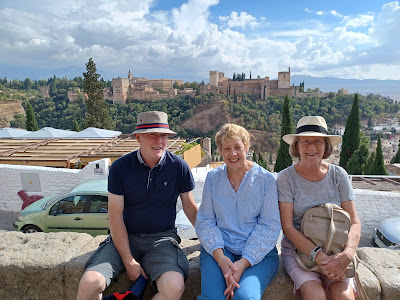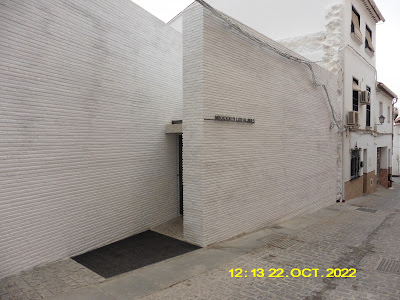They think it's all over....
The NHS Covid 'passport'
From October 21st. Spain is removing all Covid- related entry requirements. Good news indeed, especially if you've not been vaccinated. If anyone wants to check if it's true, we shall be picking our olives next week and we could do with a few volunteers. Free board and lodging and all the olives you can eat.
Be careful, though, if you arrive in Spain and want to get to your accommodation by public transport, as mascarillas (masks) are still compulsory in trains, buses and taxis. The guard was going to throw Mrs.S. off the Metro a few weeks ago for not having a mask on. As luck would have it, a kind student gave her a spare one. Good job too! I would have been sad to lose her.
I expect that many of the faithful and cultured people who regularly read this venereal organ I call 'Man in Álora' have been wondering what has happened to Mrs. Sánchez and me.
¡Mucho tiempo sin verte! (Long time no see!).
Well, we've survived the pandemic, and so far we've not had the dreaded Covid; but with all the shenanigans in Ukraine, nuclear threats by Russia, raging inflation and economic chaos in Britain and with half-wits like Johnson, Rees-Mogg, Truss, Kwarteng and the possibility of Johnson redux, in charge of the shop, and with one thing and another, life has barely been worth living - and it's all been happening so fast, too.
'It's only being so cheerful that has kept me going'. (Mona Lott, ITMA, 1947).
Mrs. S. is not up for a suicide pact just now, so we packed up our troubles, and the dog, and headed for España.
My last post was in April when Andalucía was being brutally battered by the brown rain.
Most of the walls of Álora have been painted white again and there hasn't been a drop of water since then, to speak of. The reservoirs up in El Chorro/Ardales are very low again and there are severe water restrictions around Vélez -Málaga.
21 ex-pats have been fined over 300 euros each for using too much water.
Lake Viñuela, which supplies Vélez-Málaga and much of the Axarquía region (pronounced 'Asharkeea' region) has virtually dried up and there's no rain forecast.
We've had over a week of hot, dry weather with weak sunlight ( they call it 'resol') because the sky is still full of 'calima' (the Saharan dust clouds that gave us the brown rain)
Our olives are a bit shrivelled, but we'll be picking them next week. Olive harvests are down by 40% here in the Málaga region and by 60% in Jaén , which is the biggest olive growing area in the world.
Olive trees can easily survive the hot, dry summers in Andalucía, but for two years there have been no winter rains or snow on the mountains to allow the trees to produce fruit. The giant olive plantations irrigate their trees but small olivars, like ours, depend entirely on the weather.
Who knows? what with climate change and full control of its borders, the UK may become a major olive producer, while Spain could switch to exporting solar energy.
Spanish Solar Farm.
There are already plans to build a massive photovoltaic plant here in the Guadalhorce Valley. It will cover 7 million square metres of land in the municpality of Álora alone, where three plants like the one above are planned on land between Álora town and El Chorro, which has beautiful landscapes, and the now world famous Caminito del Rey.
El Caminito del Rey
No surprise, then, that the local people of the Guadalhorce valley, in towns like, Álora, Coín, Ardales and Casarabonela, where we have our olive trees, are more than a little cross about the plans.
Barry, Stella and Mrs. Sánchez sitting on a wall in Plaza San Nícolas.
Our Day Out.
Here's a picture of Mrs. Sánchez with two friends who stayed with us last week, Stella and Barry. Shrewd and eagle-eyed observers will spot Granada's great treasure - La Alhambra. (The Alhambra) in the background. It only takes 90 minutes to drive to Granada from Álora ( 2 hours if you stop for breakfast), so we went there for the day.
The Alhambra is the 7th.most visited monument in the world (not far ahead of The Mosque at Córdoba which comes in at number 10), so you would expect it to be a bit busy, which it was. 8500 people visit the place every day You have to book a 'time slot' in advance to visit the best bits. It is estimated,(by me), that every day nearly half a million photographs are taken in and around the Alhambra, so you've all probably seen one. Just in case you haven't, here's one I took earlier .
The Court of the Myrtles
Looking round the Alhambra is a bit tiring and, in my view, it's a bit 'samey' - especially when you've visited it several times. Lots of tiles and plaster filligree decoration everywhere, and you get told off if you touch anything.
What I find really impressive is the way that water is channelled along asequías to supply all the various palaces in the Alhambra with water for all the pools and fountains, to irrigate the flower and vegetable gardens and fill the underground aljibes (water cisterns) that held water supplies for what was, after all, a fortified town expecting attack and siege from the conquering Christian forces at any time.

The Fountain of the Lions
How does the water get to the mouth of the lions?
Those Nasrids really knew a fair bit about plumbing. All the water flows continuously from the Sierra Nevada via the Rio Darro, along the 'Sultan's Canal' and a by series of aqueducts to the Generalife gardens and on to the Alhambra below.
The Sultan's Canal
The Alhambra was built between 1200 AD, and 1450 AD, towards the end of Muslim rule in Andalucía (711 AD. to1492 AD.) and has been knocked about quite a bit since. It's a wonder there's so much left of it after the French tried to blow it up in 1814 during what we call 'The Peninsular War' and the Spanish call La Guerra de la Independencia' )´The War of Independence'). They say that a crippled soldier managed to cut the fuse to the explosives just in time.
We had a lovely meal down in the town at 'Oliver', near Plaza de La Trinidád, which was just the ticket after 3 hours of 'rubbernecking'.
But who's this character dancing on the same wall in Plaza San Nícolas, Granada?
Yes, Punk Rockers and fans of The Clash it's Joe Strummer who has a plaza in Granada named after him.
Yes it's true. Lead singer and guitarist of The Clash Joe Strummer, who died suddenly in 2002, was a frequent visitor to Granada and was big fan of Federico García Lorca, the grenadine poet and playwright. Joe went there in 1984 to escape the problems he was having with the band in London. He met and recorded with '091', a local band.
Joe Strummer described himself as a 'socialist' and took an interest in Spain's recent history, particularly 'La Repressión Franquista' (The Franco Dictatorship). Lorca was murdered by falangists in 1936.
Federico García Lorca
The Placeta Joe Strummer was inaugurated in 2013 following a local campaign.
It suffered from neglect during the following years and was eventually closed to the public. Now it has been renovated and reopened.
Placeta Joe Strummer.
Back in Álora, life has now returned to normal. All the many annual fiestas and events have taken place this year, including the 'Romería de La Virgen de las Flores', which we missed. There seems to be something going on every weekend now.
Last weekend we had the 'Foodtruck Show'. Mobile food vehicles filled the top square selling exotic delicacies and there was live music late into the night which pleased the local residents no end.
Yum yum!
If you walk up (or down) Calle Atrás, you may notice a new white wall with a sign that says 'Mirador de los Aljibes'.
Mirador de los Aljibes
A 'mirador' is a place from where the public have panoramic views. In Álora they tend to keep them locked up to prevent vandalism, this and that, and one thing and another. This new one was open for a day on The Day of the Sopas Perotas (October 1st) so Mrs.S. and I managed to have a look. It's been locked up since then.There's a lovely view of the castle, which you can still see even though the gate is locked, by looking through a metal tube sticking out of the wall.
The 'mirilla' is named after Pepe Rosas who lived in the house that stood here. Pepe was a a much-loved Álora celebrity who knew everything there was to know about the local folk dances called Verdiales.
Here's what you see:
The light at the end of the tunnel. You can just about make out the castillo. (it's better when seen with the naked eye)
Watch out for the old 'black eye telescope' trick, though.
Bar News
Getting an an evening meal in Álora is getting tricky these days, especially on Fridays. All the restaurants are so busy that most of the tables are reserved by about 8.00pm. so it's best to book in advance. Even if you do reserve a table you may have a long wait, especially in La Taberna de Álora and Casa Romero.
El Taller and La Casa de Abillo are still the two best places to eat, and the food in El Gusto on Calle Cervantes is excellent and the service is great. ¡Que aproveche!
Juanito Sanchez :October 24th.2020
















.jpg)






 a
a